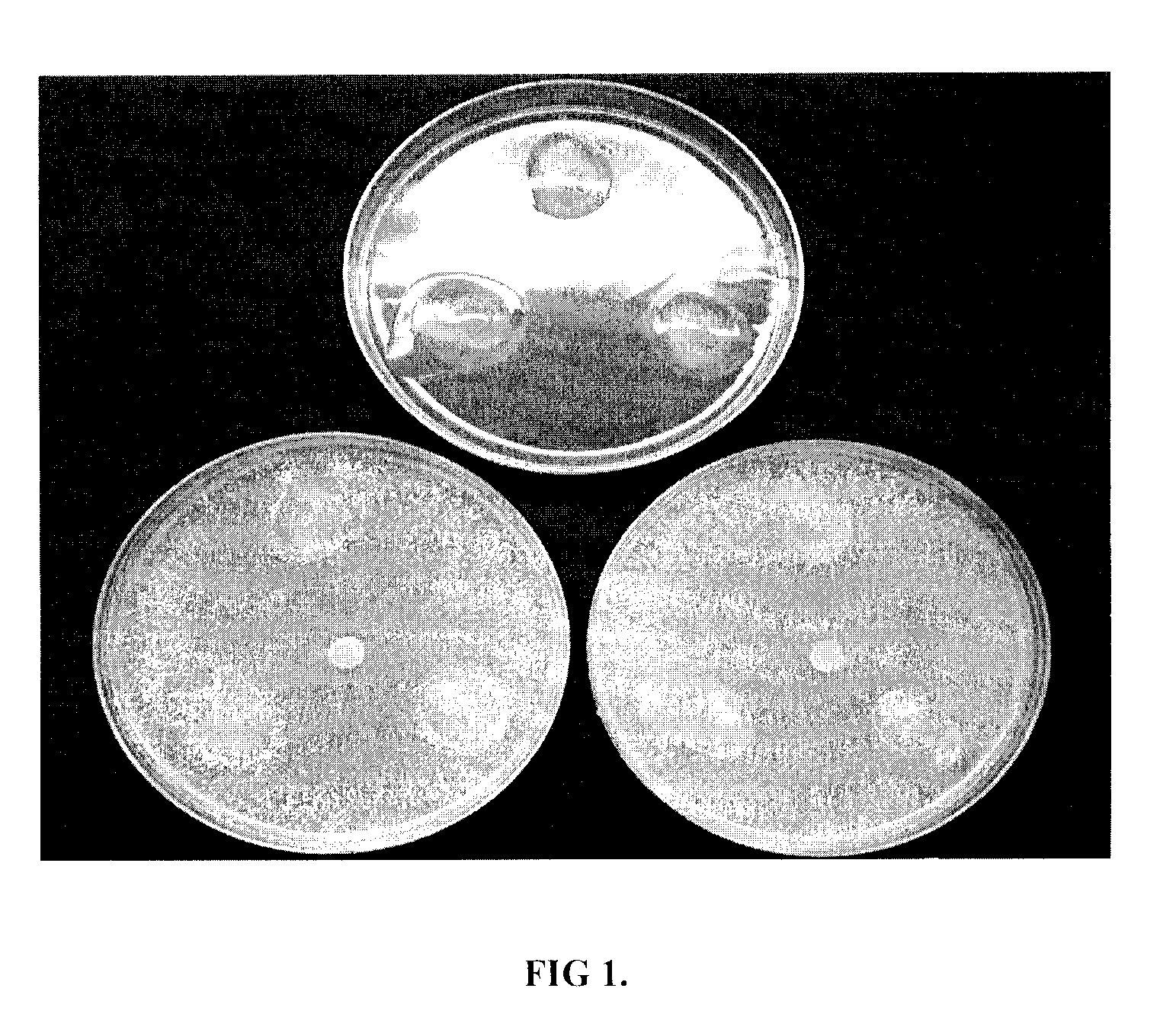Biological method to reduce wetwood content in green lumber
a technology of biochemical methods and green lumber, which is applied in the field of biochemical methods to reduce wetwood content in green lumber, can solve the problems of increased internal stresses of the lumber, increased wetwood content, and generally long drying periods, and achieve the effect of reducing wetwood conten
- Summary
- Abstract
- Description
- Claims
- Application Information
AI Technical Summary
Benefits of technology
Problems solved by technology
Method used
Image
Examples
example 1
[0026]The goal of this example was to identify an antagonistic fungus that can kill causal agents of wetwood and utilize their metabolites to reduce the wetness of infected wood. To realize this goal, various fungi species were used against six wetwood causal agents (WCA): A-a (a bacterium isolated from wetwood of aspen), A-c (a yeast isolated from wetwood of aspen), B-a (a bacterium isolated from wetwood of balsam fir), Y-2 (a yeast isolated from wetwood of balsam fir), SaB-2 (a bacterium isolated from wetwood of sub-alpine fir), and SaY-4 (a mixture of a yeast and a bacterium isolated from wetwood of sub-alpine fir). The tests were conducted in Petri plates containing a 2% malt extract agar medium (MEA). Each bacterium was inoculated at 3 points that were 2 cm away from the edge of the plate. All plates were incubated at 25° C. for 3 days, and then a mycelium plug of the test fungus, either Phlebiopsis gigantea or Gliocladium roseum, was placed in the center of each plate. Three r...
example 2
[0028]This example examined the efficacy of the treatments of wetwood lumber with selected wetwood control candidates in the laboratory conditions. The selected fungal species, Phlebiopsis gigantea and Gliocladium roseum, were cultured in 1-L flasks containing 500 ml of 1.5% malt extract broth medium. The flasks were incubated on a shaker (120 rpm) at 25° C. for 14 days, then, mycelia mass inside the flask was ground into a fungal suspension with a homogenizer. The fungal suspension was adjusted to 1×106 segments / ml. A total of 120 boards of black spruce, jack pine and balsam fir (SPF, mostly balsam fir, 2×4 inch×2 feet,) with heavy wetwood were labelled and weighed individually and put in 3 groups, 40 boards each. Two groups of boards were treated with the 2 fungi (each group was treated with 1 fungus); dipping boards 1 minute in a fungal suspension. The solution pick-up was measured as 1400 ml / 40 boards. After treatment, 20 boards in each test group were wrapped with a plastic she...
example 3
[0032]A field trial was performed on 600 SPF boards (mostly balsam fir, freshly-sawn, 2×4 inch×2 feet,) with heavy wetwood in FPInnovations-Forintek Laboratory at Quebec. The boards were divided into 6 groups, each contained 100 boards. Four groups of boards were treated with: 1) Gliocladium roseum water suspension; 2) Phlebiopsis gigantea water suspension; 3) G. roseum+P. gigantea (1:1) water suspension; and 4) G. roseum+P. gigantea (1:1) in 4% sodium carbonate and 1% sodium bicarbonate solution. Boards were dipped 1 minute in a fungal suspension. The solution pick-up was measured as 274 mL / m2 of board surface area. One group of boards served as untreated controls and another group was stored at −20° C. as fresh controls. After treatment, boards in each test group were piled in two bundles; each contained 50 boards and with stickers between each layer of boards. Two bundles of boards in each treatment group were piled together in a Forintek's yard and loosely covered with a plastic...
PUM
 Login to View More
Login to View More Abstract
Description
Claims
Application Information
 Login to View More
Login to View More - R&D
- Intellectual Property
- Life Sciences
- Materials
- Tech Scout
- Unparalleled Data Quality
- Higher Quality Content
- 60% Fewer Hallucinations
Browse by: Latest US Patents, China's latest patents, Technical Efficacy Thesaurus, Application Domain, Technology Topic, Popular Technical Reports.
© 2025 PatSnap. All rights reserved.Legal|Privacy policy|Modern Slavery Act Transparency Statement|Sitemap|About US| Contact US: help@patsnap.com

